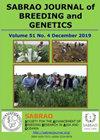地方香稻品种的耐干旱oscipk基因
IF 1.7
Q3 PLANT SCIENCES
引用次数: 0
摘要
这项前途光明的研究是在伊拉克卡尔巴拉卡尔巴拉大学农学院大田作物系的实验室进行的。以V1: Ebaa1、V2: Baraka、V3: Furat、V4: Diggla、V5: Yasmine和V6: Amber-33 6个芳香型地方水稻品种为材料。CIPK家族的10个基因是抗旱基因的指示基因。从干旱胁迫后的叶片中提取RNA转化为cDNA,利用Real Time PCR检测这些基因。结果表明,除OsCIPK04基因外,香稻品种Amber-33几乎含有所有基因。品种Furat和Diggla在基因检测上也具有优势。OsCIPK06和OsCIPK07基因出现在3个水稻品种(Diggla、Yasmine和Amber-33)中。OsCIPK08、OsCIPK09和OsCIPK10三个基因在所有芳香型水稻品种中均不存在,而OsCIPK05基因在干旱胁迫条件下均存在。水稻作物OsCIPK基因检测技术与田间试验结果相匹配,可用于水稻品种筛选和耐旱性鉴定。本文章由计算机程序翻译,如有差异,请以英文原文为准。
DROUGHT-TOLERANT OSCIPK GENES IN LOCAL AROMATIC RICE CULTIVARS
The promising study transpired in the laboratory of the Department of Field Crops, College of Agriculture, University of Karbala, Karbala, Iraq. The six aromatic local rice cultivars, i.e., V1: Ebaa1, V2: Baraka, V3: Furat, V4: Diggla, V5: Yasmine, and V6: Amber-33, served as materials in the presented study. Ten genes of the CIPK family were indicators for drought-tolerant genes. Detecting these genes from the leaves after exposure to drought stress used the Real Time device PCR after RNA extraction and converted to cDNA. The results revealed that the aromatic rice cultivar Amber-33 contained almost all the genes except the gene, OsCIPK04. Cultivars Furat and Diggla were also superior for gene detection. The genes OsCIPK06 and OsCIPK07 appeared in three rice cultivars (Diggla, Yasmine, and Amber-33). The three genes, i.e., OsCIPK08, OsCIPK09, and OsCIPK10, were absent in all the aromatic rice cultivars, while the OsCIPK05 gene appeared in all the studied rice cultivars under drought stress conditions. The technique used for detecting OsCIPK genes in the rice crop, matched with the results in the field experiments, resulted in the potential use of this method to screen the rice cultivars and determine their degree of drought tolerance.
求助全文
通过发布文献求助,成功后即可免费获取论文全文。
去求助
来源期刊

Sabrao Journal of Breeding and Genetics
农林科学-奶制品与动物科学
CiteScore
1.90
自引率
50.00%
发文量
63
期刊介绍:
The SABRAO Journal of Breeding and Genetics is an international journal of plant breeding and genetics research and was first published in 1969. It is the official publication of the Society for the Advancement of Breeding Research in Asia and Oceania (SABRAO).
Its objectives are to: promote the international exchange of research information on plant breeding and genetics, by describing new research findings, or ideas of a basic or practical nature; and be a medium for the exchange of ideas and news regarding members of the Society.
The Journal gives priority to articles that are of direct relevance to plant breeders and with emphasis on the Asian region. Invited for publication are research articles, short communications, methods, reviews, commentaries, and opinion articles. Scientific contributions are refereed and edited to international standards.
The journal publishes articles for SABRAO members mainly. The Journal preferred strongly that at least one author should be a current member of the Society. Non-members may also publish in the journal.
 求助内容:
求助内容: 应助结果提醒方式:
应助结果提醒方式:


